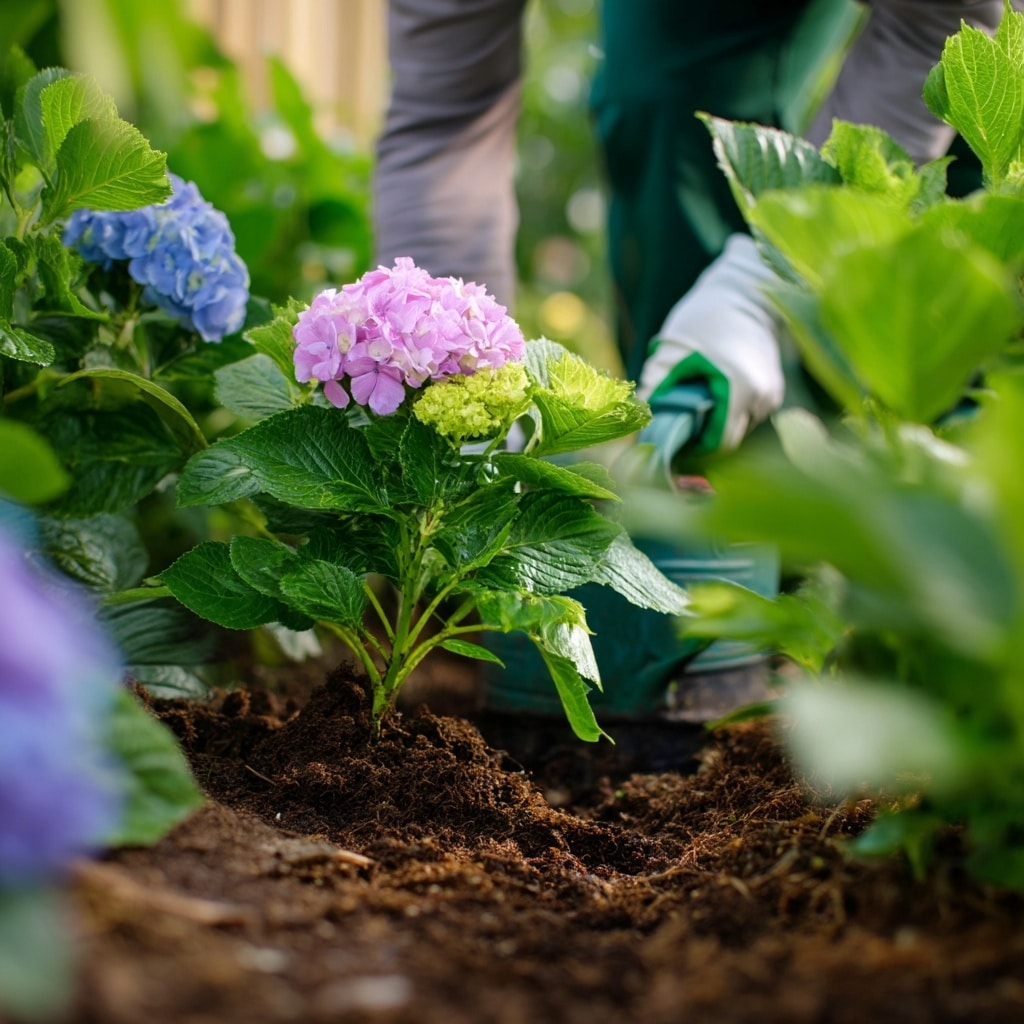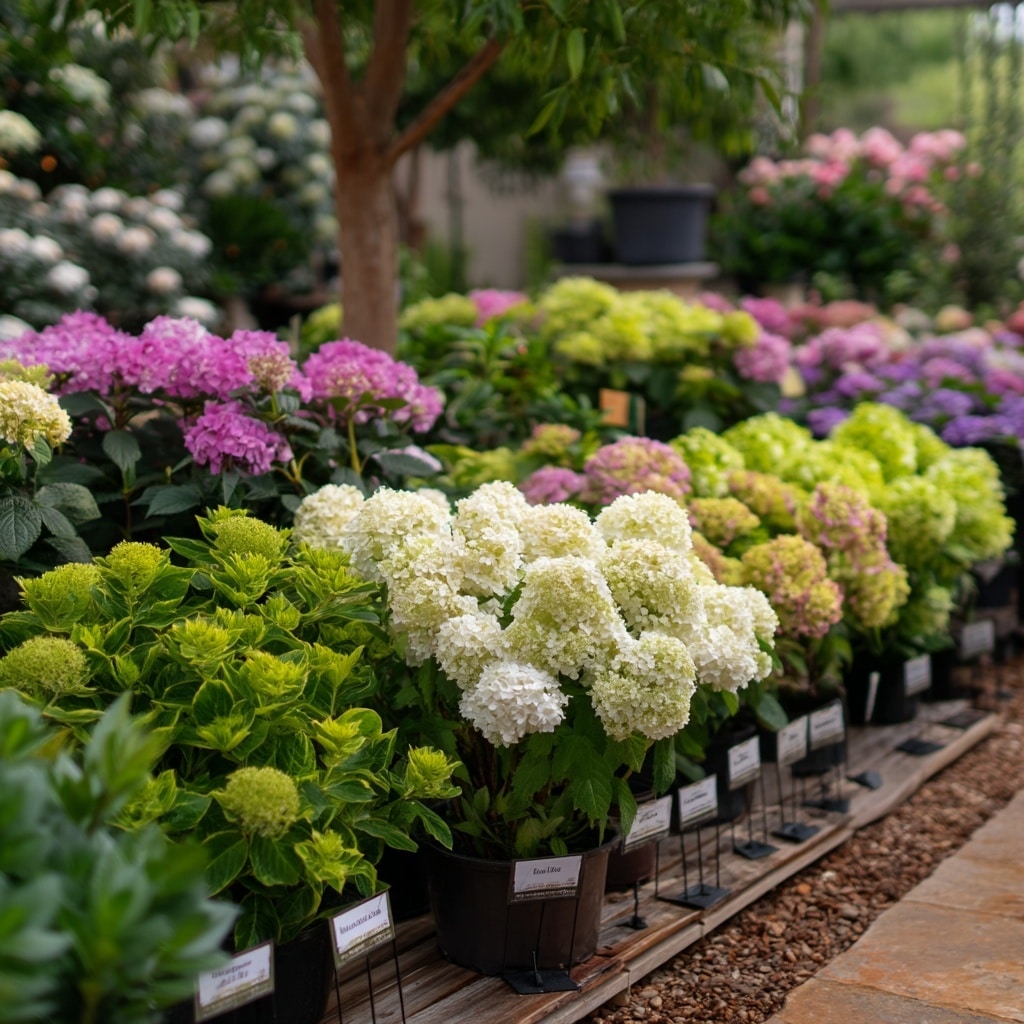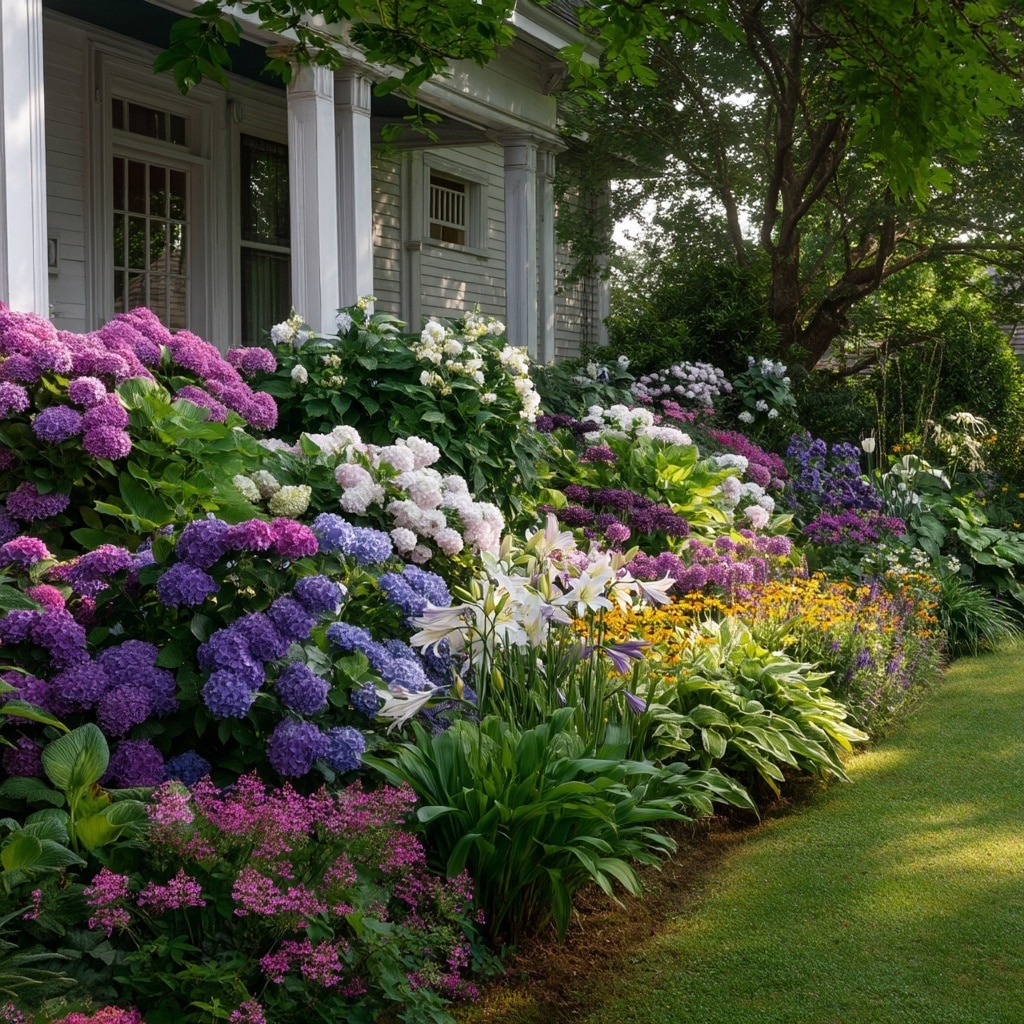Hydrangeas are beloved flowering shrubs known for their vibrant blooms, charming structure, and adaptability in a wide range of garden styles. Whether you’re dreaming of soft pink mopheads or vivid blue clusters that change with soil pH, hydrangeas bring beauty from summer into fall. Hardy across USDA zones 3 through 9, these versatile plants thrive best in partial shade and moist, well-drained soil, making them ideal for both beginner gardeners and seasoned enthusiasts. With just a few care essentials, hydrangeas reward you with a spectacular show of flowers year after year.
Table of Contents
Hydrangea Basics
Hydrangeas come in a wide variety of shapes, sizes, and bloom styles, which makes them one of the most versatile shrubs in the garden. Before planting, it’s helpful to understand a few key characteristics to choose the right variety for your space and climate.
🌎 Growing Zones
Most hydrangeas are hardy in USDA zones 3 to 9, though some types are more cold-tolerant than others. If you live in an area with harsh winters or hot summers, selecting a variety suited to your zone is crucial for healthy growth.
📏 Size & Spread
Depending on the type, hydrangeas can range in size from compact 3-foot varieties perfect for containers to towering 15-foot shrubs that make a dramatic garden statement. Be sure to check the mature height and width before planting to avoid crowding.
☀️ Light Requirements
Hydrangeas prefer partial shade, especially afternoon shade in hotter climates. In northern regions, they can often tolerate more sun, while southern gardeners should prioritize morning sun and afternoon protection to prevent leaf scorch.
🌸 Bloom Time
Most hydrangeas begin to bloom in early to mid-summer, with some continuing their display into late fall. The exact bloom period can vary by variety and local climate.
🎨 Flower Colors
Hydrangea flowers are known for their stunning color palette — from deep blues and purples to pinks, whites, and even lime greens. In varieties like Bigleaf and Mountain hydrangeas, the soil pH can actually influence the color:
- Acidic soil (pH < 6) = blue flowers
- Alkaline soil (pH > 7) = pink flowers
This magical color-shifting ability makes hydrangeas not just beautiful, but interactive.
🌿 Types of Hydrangeas
There are six main types of hydrangeas commonly grown in gardens:
- Bigleaf (Hydrangea macrophylla) – large, colorful blooms, affected by soil pH
- Oakleaf (Hydrangea quercifolia) – bold foliage with cone-shaped flowers
- Climbing (Hydrangea anomala petiolaris) – vines that cling to walls and structures
- Panicle (Hydrangea paniculata) – upright flower clusters, very cold-hardy
- Smooth (Hydrangea arborescens) – native, easy-care shrubs
- Mountain (Hydrangea serrata) – similar to bigleaf but smaller and more cold-tolerant
Many of these also come in dwarf or tree-form varieties to suit different landscaping needs.
⚠️ Are Hydrangeas Toxic?
Yes. The leaves and flower buds of hydrangeas can be toxic if ingested by pets, especially cats and dogs. It’s best to keep curious animals away from these plants or opt for pet-safe landscaping alternatives.
How to Plant Hydrangeas

Getting hydrangeas off to the right start is essential for strong roots, healthy growth, and abundant blooms. While these shrubs are forgiving and adaptable, a little planning goes a long way when planting in the ground or containers.
📅 When to Plant Hydrangeas
The best times to plant hydrangeas are in early spring or early fall, when temperatures are mild and there’s no threat of frost. This gives roots time to establish before the extreme heat or cold of summer and winter.
📍 Where to Plant Hydrangeas
Choose a spot that balances sunlight and protection:
- Morning sun, afternoon shade is ideal.
- In cooler climates (zones 3–5), they can handle full sun if the soil stays moist.
- Avoid planting under large trees, which create root competition and too much shade.
- Protect from strong winds, which can break delicate stems and flowers.
Make sure the area has:
- Excellent drainage
- Amended soil with compost or organic matter
- Enough space for mature growth (check the plant label for spacing guidelines)
🌱 How to Plant in the Ground
- Prepare the hole
Dig a hole that’s 2–3 times wider than the root ball and just as deep. - Amend the soil
Mix in up to 15% organic compost and a slow-release fertilizer (use half the recommended amount). - Place the plant
Position the hydrangea so the top of the root ball is slightly above ground level to avoid water pooling. - Loosen the roots
If the roots are tightly bound in the container, gently tease them apart to encourage outward growth. - Backfill & water
Fill the hole with amended soil, firm it gently, and water thoroughly. - Space properly
Leave at least 3 feet between plants (more for larger varieties) to ensure proper air circulation and growth.
🪴 How to Plant in Pots
Hydrangeas thrive in containers if the pot is:
- Large enough for mature root spread
- Has drainage holes to prevent soggy soil
Potting Steps:
- Use a quality potting mix (not garden soil)
- Mix in slow-release fertilizer
- Leave 1–2 inches between soil surface and the pot’s rim for watering
- Water thoroughly and place in a location with bright indirect light
Container-grown hydrangeas may need daily watering in summer and benefit from regular fertilization every 6–8 weeks.
Caring for Hydrangeas

Once planted, hydrangeas are relatively easy to maintain, but they do have a few preferences that can make the difference between weak blooms and a vibrant showstopper. Here’s how to keep your plants healthy and thriving year after year.
💧 Watering Hydrangeas
Hydrangeas prefer consistently moist soil—not soggy, and never bone-dry. As a rule:
- Water deeply 1–3 times per week, depending on weather and soil type.
- Container plants often require daily watering, especially in hot weather.
- Mulch around the base (2–3 inches thick) to retain moisture and suppress weeds.
🌡️ Pro tip: During hot spells, check soil moisture with your finger. If the top inch is dry, it’s time to water.
🌱 Soil & Fertilizing
Hydrangeas thrive in rich, well-draining soil with added organic matter. The soil type also influences bloom color in certain varieties like Bigleaf and Mountain hydrangeas.
- Amend soil yearly with compost or well-rotted manure.
- Apply a slow-release fertilizer (such as 15-10-10) in early spring.
- Avoid high-nitrogen fertilizers—they encourage leaves at the expense of blooms.
🌸 Want blue blooms? Acidify the soil with aluminum sulfate.
🌸 Prefer pink? Add garden lime to raise the pH.
✂️ Pruning Hydrangeas
Not all hydrangeas are pruned the same way. First, determine whether your variety blooms on:
- Old wood (last year’s growth)
- New wood (current season’s growth)
- Both (reblooming types)
General pruning tips:
- Remove dead wood and spent blooms any time of year.
- Prune old-wood bloomers (e.g., Bigleaf) after flowering, not in spring.
- Prune new-wood types (e.g., Panicle, Smooth) in late winter or early spring before new growth appears.
🐛 Pests & Disease
Hydrangeas are relatively pest-free, but occasional issues may include:
- Aphids or spider mites – Spray with insecticidal soap or neem oil
- Japanese beetles – Handpick or use traps
- Leaf spot, powdery mildew, or bud blight – Improve air circulation and avoid overhead watering
Monitor your plants regularly and treat problems early to avoid major damage.
😕 Why Isn’t My Hydrangea Blooming?
If your hydrangeas are healthy but not blooming, the issue could be:
- Incorrect pruning – Pruning old wood varieties too late cuts off next year’s buds.
- Cold damage – Late frosts can kill flower buds; cover plants during cold snaps.
- Too much shade – While they like some shade, too little sun = no blooms.
- Overfertilizing – Especially with nitrogen-heavy formulas.
Popular Hydrangea Varieties to Grow

With dozens of cultivars available, choosing the right hydrangeas for your garden can feel overwhelming. Here are a few standout varieties that combine stunning blooms, hardiness, and garden versatility — whether you’re planting in borders, pots, or as focal points.
🌿 Limelight Prime® (Hydrangea paniculata)
- Zones: 3–8
- Exposure: Part sun to full sun
- Size: 4–6 feet tall and wide
- Bloom Time: Early summer to fall
- Flower Color: Lime green turning to pink-red
This improved version of the classic ‘Limelight’ blooms earlier and lasts longer, making it ideal for short-season climates. It’s compact enough for small spaces but bold enough for statement planting.
🍂 Oakleaf Hydrangea (Hydrangea quercifolia)
- Zones: 5–9
- Exposure: Partial shade
- Size: 4–8 feet tall, 4–6 feet wide
- Bloom Time: Late spring to early summer
- Flower Color: White, aging to pink
Loved for its distinctive foliage that turns crimson in fall, oakleaf hydrangeas offer multi-season interest. Their cone-shaped flower clusters and coarse texture make them a great choice for woodland gardens or naturalistic plantings.
🪻 Endless Summer® (Hydrangea macrophylla)
- Zones: 4–9
- Exposure: Morning sun, afternoon shade
- Size: 3–5 feet tall and wide
- Bloom Time: Late spring through fall
- Flower Color: Blue, pink, or purple depending on soil pH
A reblooming Bigleaf hydrangea, this cultivar offers continuous color throughout the season. It’s a top pick for foundation beds and border plantings.
🌸 Annabelle (Hydrangea arborescens)
- Zones: 3–9
- Exposure: Part sun
- Size: 3–5 feet tall and wide
- Bloom Time: Mid-summer
- Flower Color: Bright white
Famous for its massive snowball blooms, ‘Annabelle’ is a smooth hydrangea variety that thrives even in colder regions. It’s a favorite for traditional cottage gardens and looks striking when planted in drifts.
🌾 Tuff Stuff™ (Hydrangea serrata)
- Zones: 5–9
- Exposure: Part shade
- Size: 2–3 feet tall and wide
- Bloom Time: Summer to fall
- Flower Color: Blue to pink lacecap
Compact and cold-hardy, this Mountain hydrangea delivers dainty, elegant flowers in a smaller footprint. It’s excellent for containers, patios, and small garden spaces.
Landscaping with Hydrangeas

Hydrangeas are more than just pretty flowers — they’re powerful design elements that can add structure, color, and seasonal drama to any garden. Thanks to their variety of sizes and flower forms, you can use them in multiple ways to suit formal landscapes, cottage gardens, or modern designs.
🌿 Use as Foundation Plants
Hydrangeas work beautifully as foundation shrubs near the home. Varieties like Bigleaf and Panicle hydrangeas create a lush, elegant backdrop that softens hard architectural lines and provides color from summer into fall.
Tip: Use dwarf or compact cultivars near entryways or walkways to prevent overcrowding.
Feature in Borders and Beds
Plant hydrangeas alongside perennials and other shrubs in mixed borders for long-lasting impact. Their large flower heads and bold foliage contrast beautifully with finer-textured plants.
Great companions:
- Garden phlox
- Astilbe
- Hostas
- Daylilies
- Ferns
These combinations provide multi-season interest and help balance the hydrangea’s size and shape.
Grow in Containers
Smaller hydrangea types such as Tuff Stuff™, Mini Penny, or Little Lime® are ideal for container gardens. Use them to:
- Frame an entryway
- Brighten up patios and decks
- Add height and color to a small garden space
Make sure containers are large enough, have good drainage, and are placed in areas with appropriate light levels.
Create a Living Screen or Hedge
Some hydrangeas — especially Panicle and Smooth varieties — can be grown as informal hedges or privacy screens. Plant them in staggered rows for a naturalistic look, or line them up evenly for a more manicured style.
Bonus: These shrubs also provide seasonal screening when grown along fences or near patios.
Design with Foliage and Texture
Don’t forget about the foliage! Hydrangeas like Oakleaf offer bold, deeply lobed leaves that turn shades of burgundy and orange in fall, adding year-round beauty. These are especially effective in woodland borders or shaded corners of the yard.
Play with Color Themes
Use blue and pink hydrangeas to build color themes in the garden:
- Combine blue blooms with lavender, salvia, and ornamental grasses for a cool-toned, calming palette.
- Pair pink flowers with roses, coneflowers, and zinnias for a romantic, warm-toned border.
White varieties like Annabelle or Incrediball® create a classic look and blend seamlessly with any color scheme.
Conclusion

Hydrangeas are an essential addition to any garden, offering unmatched beauty, versatility, and seasonal interest. With just a bit of attention to planting location, soil conditions, and pruning techniques, you can enjoy these stunning blooms for many years. Whether you’re creating a romantic cottage garden or a modern landscape with structure and flair, there’s a hydrangea variety to suit your vision. From containers to borders, hedges to foundation plantings, hydrangeas deliver big impact with minimal fuss.
So grab your shovel, pick your favorite variety, and let hydrangeas transform your outdoor space into a vibrant, flowering retreat.





